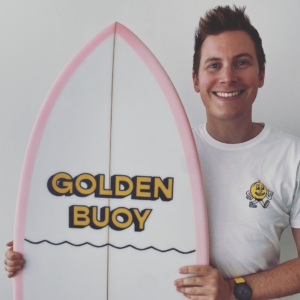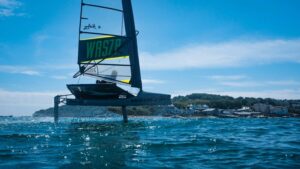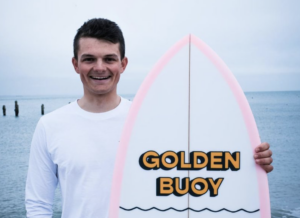Golden Buoy with Paul O’Brien
1. Hi Paul! You’re the founder of Golden Buoy, a water sports clothing and accessory brand committed to ethical business practices. Can you tell me what inspired you to start it?

I wanted a creative outlet from the day job, and having spent a decade working in digital marketing, branding and e-commerce for big corporates I realised I had the skills required to work on something fun myself. I had a wardrobe full of surf-style t-shirts from the big brands, but none of them offered sustainable or ethical options so I started looking into creating a clothing brand that I’d be happy to hang in my wardrobe whilst focussing heavily on the sustainability side in manufacture and distribution.
2. The T-shirts you sell have fun and bold designs that remind me of retro hand-painted signs. Are these your own works, or do work with illustrators? What made you choose this aesthetic for your clothes?
When I choose to buy a t-shirt it’s always because of the design that’s printed onto it, so it was hugely important to get that spot on. My skills lie in marketing and websites, but without a decent product to feature I wouldn’t be very successful in selling anything. I can’t draw at all, so I spent a few months searching for the right person to collaborate with. I found Aron (aka Fried Cactus Studio) via Dribbble and initially just asked for help creating the Golden Buoy mascot as I had a specific vision in mind. Many months later and he’s been churning out design after design for me and we’re really getting to know what our audience reacts well to. I love retro advertising and timeless surf designs, and Aron has been doing that style for ages so it was a perfect partnership and I’m really excited to work on many more designs with him moving forward.
3. You use biodegradable paper packaging, and you don’t use plastic at any stage of your process. But that’s not the only thing that’s positive about buying your t-shirts! Can you tell me about your link with the RNLI?
It really annoys me when I open a package from a retailer and find the contents individually wrapped in plastic, with tags attached that just have the logo on and need to be thrown away for you to use the product. For me it’s unnecessary waste, and an additional cost to cover for no benefit. I receive and store all my products neatly folded in cardboard boxes, then when an order comes through I simply slide them into a biodegradable paper package, allowing the customer to just open the bag and have nothing to throw away.
I purchased a top from a large online store recently, and it arrived in a similarly eco-friendly postal packet, but then the t-shirt inside was in a plastic sleeve with tags attached and it felt awful having to bin it after such an effort was made with the external materials.
Ethical business practices are a no-brainer for me. Aside from all of the environmental impact considerations, and ensuring the t-shirts are manufactured safely and fairly, I wanted to do something positive at the other end of the funnel. If I’m able to make some money from creating a product, I want to use that money to do good. So I’ve committed to donating £1 from every t-shirt sold to the lifeboats. It’s a charity that benefits water users everywhere, so it seemed to be the most appropriate use for the money as Golden Buoy is a brand for all watersports enthusiasts.
4. Something that makes it difficult to get a sustainable brand off the ground is the extra cost in using ethical materials and processes, when less ethical ones are far cheaper. How did you get started? Do you have any advice for someone starting an eco-friendly business of their own?
It is astonishing how much more expensive sustainable materials are compared to single-use plastic, although this highlights why brands are so reluctant to make the switch when they’ve managed to make huge sums of money over the years doing what they currently do. If someone isn’t bothered about sustainability when creating a brand the numbers would definitely sway them towards less ethical materials.
I started very cautiously. I invested my own cash into small volumes of t-shirts and packaging from my attic. It still wasn’t cheap, but it was a risk I was willing to take. After selling out and re-stocking a few times, releasing a couple of new designs and still selling out rapidly I knew I would need to invest more to scale the brand, so a few weeks ago I received a cash injection from a government startup scheme and I’m in the process of producing much larger volumes of existing designs as well as creating more products to expand the range.
There are platforms available that enable brands to produce designs then only print t-shirts when an order comes through, so that might be a good approach for someone starting out, however I avoided those platforms as I wanted to have full control over the quality of the products and packaging, so having the stock in advance to ensure I’m happy with it and being able to personally pack each order up was an important point for me.
When I applied for the startup scheme with the government I had to do a cashflow forecast and profit and loss. This is something I’d highly recommend anyone doing if they’re thinking of setting up an eco-friendly business. Do some research into costs and see if it’s a viable business option for you. Most businesses don’t turn a profit for a very long time, so being able to map out how much income the business can generate to support future production is really helpful.
5. Another thing Golden Buoy does to give back to the seaside culture is sponsoring athletes. What qualifies an athlete to be a part of your brand? Who are you sponsoring at the moment?

These athletes are spending every day on the water training, which sounds idyllic, but they work super hard to get to the top of their game and often struggle to earn an income to support that lifestyle. There are large brands supporting the small number of athletes who are already world title holders, so for the next generation of elite athletes I wanted to be in a position to help them get there. Of course I want to get my brand out in front of a relevant audience, so this is an effective method, but building a great relationship with hard-working athletes and watching them succeed is going to be a load of fun too. I’m focussing a lot on creating quality content for Golden Buoy, so I’m going to be filming and photographing these guys a load over the coming year to build up a bank for sharing online.
So far I’ve been keeping an eye out for rising stars and reaching out to them to see what their situation is to see if I can support them, but I’d also welcome incoming enquiries from athletes of any watersport discipline to get in touch. They don’t need to be world class, I’m happy to consider support for all levels with their passion for competing.
I’m working with Sam Whaley, a sailor from Dorset, to support his campaign to become the best Waszp sailor in the world, and we’re also working on a challenge attempt which I’ll be making a mini documentary about. I’m also finalising details with a windsurfer and exploring options with a young kitesurfer which I’m hoping to make public over the coming months. Lockdown really put the brakes on a lot of discussions as competitions have been cancelled for the near future so a lot of athletes have been in limbo.

6. What would you like to suggest as your WFTP Hidden Gem?
The Ocean Cleanup is a project that I really think should be more well known. Every time I see their progress I wonder why it’s not reported on mainstream news as it’s such a positive operation to clear global waterways of litter and pollution, including the The Great Pacific Garbage Patch. They’ve developed boats that intercept plastic from rivers before it can reach the ocean, they’re sending ships out to pull rubbish from the sea and they’re looking into creating products from the waste they collect.
Thanks a lot for chatting to me! Please let us know where we can buy your clothing, and how we can keep up to date with what you do.
Thanks Alex, it’s been a pleasure! I sell everything through www.goldenbuoy.com and you can follow the brand on Instagram @goldenbuoyclothing.